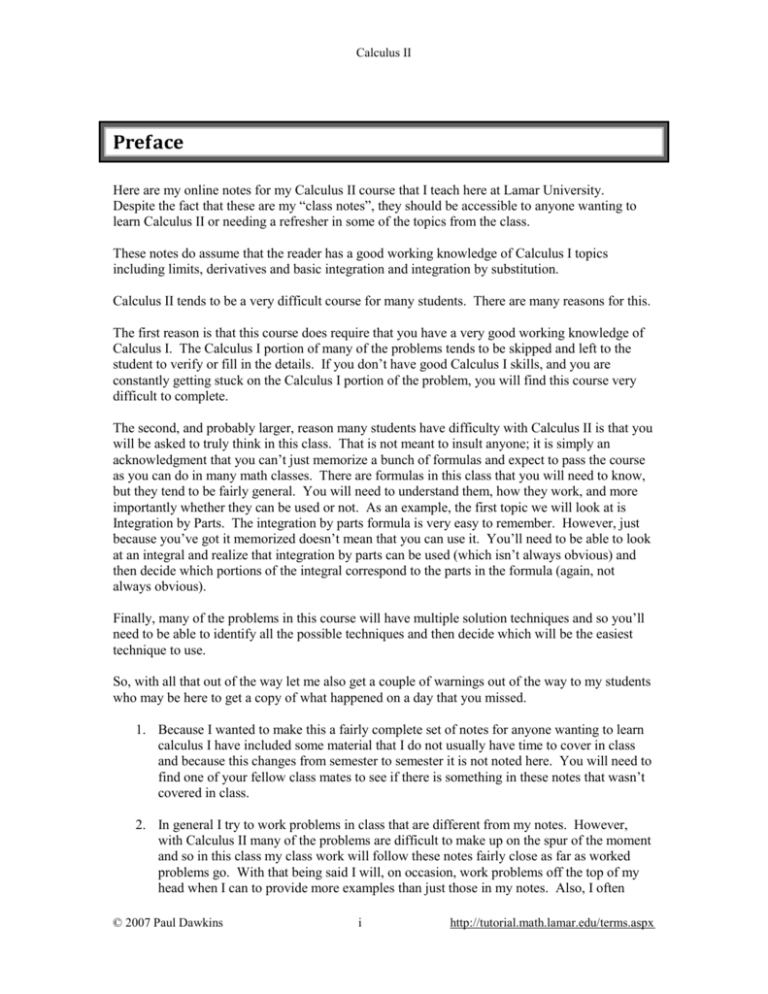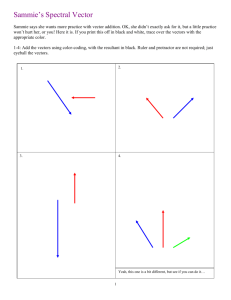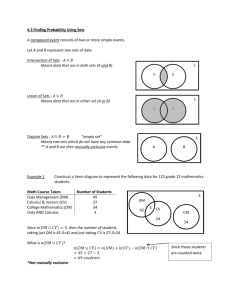01_ADVANCED_CrossPro..
advertisement

Calculus II Preface Here are my online notes for my Calculus II course that I teach here at Lamar University. Despite the fact that these are my “class notes”, they should be accessible to anyone wanting to learn Calculus II or needing a refresher in some of the topics from the class. These notes do assume that the reader has a good working knowledge of Calculus I topics including limits, derivatives and basic integration and integration by substitution. Calculus II tends to be a very difficult course for many students. There are many reasons for this. The first reason is that this course does require that you have a very good working knowledge of Calculus I. The Calculus I portion of many of the problems tends to be skipped and left to the student to verify or fill in the details. If you don’t have good Calculus I skills, and you are constantly getting stuck on the Calculus I portion of the problem, you will find this course very difficult to complete. The second, and probably larger, reason many students have difficulty with Calculus II is that you will be asked to truly think in this class. That is not meant to insult anyone; it is simply an acknowledgment that you can’t just memorize a bunch of formulas and expect to pass the course as you can do in many math classes. There are formulas in this class that you will need to know, but they tend to be fairly general. You will need to understand them, how they work, and more importantly whether they can be used or not. As an example, the first topic we will look at is Integration by Parts. The integration by parts formula is very easy to remember. However, just because you’ve got it memorized doesn’t mean that you can use it. You’ll need to be able to look at an integral and realize that integration by parts can be used (which isn’t always obvious) and then decide which portions of the integral correspond to the parts in the formula (again, not always obvious). Finally, many of the problems in this course will have multiple solution techniques and so you’ll need to be able to identify all the possible techniques and then decide which will be the easiest technique to use. So, with all that out of the way let me also get a couple of warnings out of the way to my students who may be here to get a copy of what happened on a day that you missed. 1. Because I wanted to make this a fairly complete set of notes for anyone wanting to learn calculus I have included some material that I do not usually have time to cover in class and because this changes from semester to semester it is not noted here. You will need to find one of your fellow class mates to see if there is something in these notes that wasn’t covered in class. 2. In general I try to work problems in class that are different from my notes. However, with Calculus II many of the problems are difficult to make up on the spur of the moment and so in this class my class work will follow these notes fairly close as far as worked problems go. With that being said I will, on occasion, work problems off the top of my head when I can to provide more examples than just those in my notes. Also, I often © 2007 Paul Dawkins i http://tutorial.math.lamar.edu/terms.aspx Calculus II don’t have time in class to work all of the problems in the notes and so you will find that some sections contain problems that weren’t worked in class due to time restrictions. 3. Sometimes questions in class will lead down paths that are not covered here. I try to anticipate as many of the questions as possible in writing these up, but the reality is that I can’t anticipate all the questions. Sometimes a very good question gets asked in class that leads to insights that I’ve not included here. You should always talk to someone who was in class on the day you missed and compare these notes to their notes and see what the differences are. 4. This is somewhat related to the previous three items, but is important enough to merit its own item. THESE NOTES ARE NOT A SUBSTITUTE FOR ATTENDING CLASS!! Using these notes as a substitute for class is liable to get you in trouble. As already noted not everything in these notes is covered in class and often material or insights not in these notes is covered in class. © 2007 Paul Dawkins ii http://tutorial.math.lamar.edu/terms.aspx Calculus II Cross Product In this final section of this chapter we will look at the cross product of two vectors. We should note that the cross product requires both of the vectors to be three dimensional vectors. Also, before getting into how to compute these we should point out a major difference between dot products and cross products. The result of a dot product is a number and the result of a cross product is a vector! Be careful not to confuse the two. r r So, let’s start with the two vectors a = a1 , a2 , a3 and b = b1 , b2 , b3 then the cross product is given by the formula, r r a ´ b = a2b3 - a3b2 , a3b1 - a1b3 , a1b2 - a2b1 This is not an easy formula to remember. There are two ways to derive this formula. Both of them use the fact that the cross product is really the determinant of a 3x3 matrix. If you don’t know what this is that is don’t worry about it. You don’t need to know anything about matrices or determinants to use either of the methods. The notation for the determinant is as follows, r i r r a ´ b = a1 b1 r j a2 b2 r k a3 b3 The first row is the standard basis vectors and must appear in the order given here. The second r r row is the components of a and the third row is the components of b . Now, let’s take a look at the different methods for getting the formula. The first method uses the Method of Cofactors. If you don’t know the method of cofactors that is fine, the result is all that we need. Here is the formula. r r a a ´b = 2 b2 a3 r a1 a3 r a1 a2 r ij+ k b3 b1 b3 b1 b2 where, a b = ad - bc c d This formula is not as difficult to remember as it might at first appear to be. First, the terms alternate in sign and notice that the 2x2 is missing the column below the standard basis vector that multiplies it as well as the row of standard basis vectors. The second method is slightly easier; however, many textbooks don’t cover this method as it will only work on 3x3 determinants. This method says to take the determinant as listed above and then copy the first two columns onto the end as shown below. © 2007 Paul Dawkins 3 http://tutorial.math.lamar.edu/terms.aspx Calculus II r i r r a ´ b = a1 b1 r j a2 b2 r r r k i j a3 a1 a2 b3 b1 b2 We now have three diagonals that move from left to right and three diagonals that move from right to left. We multiply along each diagonal and add those that move from left to right and subtract those that move from right to left. This is best seen in an example. We’ll also use this example to illustrate a fact about cross products. r r Example 1 If a = 2,1, -1 and b = -3, 4,1 compute each of the following. r r (a) a ´ b r r (b) b ´ a Solution (a) Here is the computation for this one. r r r r r i j k i j r r a ´ b = 2 1 -1 2 1 -3 4 1 -3 4 r r r r r r = i (1)(1) + j ( -1)( -3) + k ( 2 )( 4 ) - j ( 2 )(1) - i ( -1)( 4 ) - k (1)( -3) r r r = 5i + j + 11k (b) And here is the computation for this one. r r r r r i j k i j r r b ´ a = -3 4 1 -3 4 2 1 -1 2 1 r r r r r r = i ( 4 )( -1) + j (1)( 2 ) + k ( -3)(1) - j ( -3)( -1) - i (1)(1) - k ( 4 )( 2 ) r r r = -5i - j - 11k Notice that switching the order of the vectors in the cross product simply changed all the signs in the result. Note as well that this means that the two cross products will point in exactly opposite directions since they only differ by a sign. We’ll formalize up this fact shortly when we list several facts. There is also a geometric interpretation of the cross product. First we will let q be the angle r r between the two vectors a and b and assume that 0 £ q £ p , then we have the following fact, r r r r a ´ b = a b sin q (1) and the following figure. © 2007 Paul Dawkins 4 http://tutorial.math.lamar.edu/terms.aspx Calculus II There should be a natural question at this point. How did we know that the cross product pointed in the direction that we’ve given it here? First, as this figure, implies the cross product is orthogonal to both of the original vectors. This will always be the case with one exception that we’ll get to in a second. Second, we knew that it pointed in the upward direction (in this case) by the “right hand rule”. r r This says that if we take our right hand, start at a and rotate our fingers towards b our thumb r r will point in the direction of the cross product. Therefore, if we’d sketched in b ´ a above we would have gotten a vector in the downward direction. Example 2 A plane is defined by any three points that are in the plane. If a plane contains the points P = (1, 0, 0 ) , Q = (1,1,1) and R = ( 2, -1,3) find a vector that is orthogonal to the plane. Solution The one way that we know to get an orthogonal vector is to take a cross product. So, if we could find two vectors that we knew were in the plane and took the cross product of these two vectors we know that the cross product would be orthogonal to both the vectors. However, since both the vectors are in the plane the cross product would then also be orthogonal to the plane. So, we need two vectors that are in the plane. This is where the points come into the problem. Since all three points lie in the plane any vector between them must also be in the plane. There are many ways to get two vectors between these points. We will use the following two, uuur PQ = 1 - 1,1 - 0,1 - 0 = 0,1,1 uuur PR = 2 - 1, -1 - 0,3 - 0 = 1, -1,3 The cross product of these two vectors will be orthogonal to the plane. So, let’s find the cross product. © 2007 Paul Dawkins 5 http://tutorial.math.lamar.edu/terms.aspx Calculus II r r r i j k uuur uuur PQ ´ PR = 0 1 1 1 -1 3 r r r = 4i + j - k r r r r i j 0 1 1 -1 r So, the vector 4i + j - k will be orthogonal to the plane containing the three points. Now, let’s address the one time where the cross product will not be orthogonal to the original r r vectors. If the two vectors, a and b , are parallel then the angle between them is either 0 or 180 degrees. From (1) this implies that, r r a ´b = 0 From a fact about the magnitude we saw in the first section we know that this implies r r r a ´b = 0 In other words, it won’t be orthogonal to the original vectors since we have the zero vector. This does give us another test for parallel vectors however. Fact r r r r r If a ´ b = 0 then a and b will be parallel vectors. Let’s also formalize up the fact about the cross product being orthogonal to the original vectors. Fact r r r r r r r Provided a ´ b ¹ 0 then a ´ b is orthogonal to both a and b . Here are some nice properties about the cross product. Properties r r r If u , v and w are vectors and c is a number then, r r r r u ´ v = -v ´ u r r r r r r r u ´ ( v + w) = u ´ v + u ´ w u1 r r r u g( v ´ w) = v1 w1 u2 v2 w2 r r r r r r ( cu ) ´ v = u ´ ( cv ) = c ( u ´ v ) r r r r r r u g( v ´ w ) = ( u ´ v )g w u3 v3 w3 The determinant in the last fact is computed in the same way that the cross product is computed. We will see an example of this computation shortly. There are a couple of geometric applications to the cross product as well. Suppose we have three r r r vectors a , b and c and we form the three dimensional figure shown below. © 2007 Paul Dawkins 6 http://tutorial.math.lamar.edu/terms.aspx Calculus II The area of the parallelogram (two dimensional front of this object) is given by, r r Area = a ´ b and the volume of the parallelepiped (the whole three dimensional object) is given by, r r r Volume = a g b ´ c ( ) Note that the absolute value bars are required since the quantity could be negative and volume isn’t negative. We can use this volume fact to determine if three vectors lie in the same plane or not. If three vectors lie in the same plane then the volume of the parallelepiped will be zero. r r r Example 3 Determine if the three vectors a = 1, 4, -7 , b = 2, -1, 4 and c = 0, -9,18 lie in the same plane or not. Solution So, as we noted prior to this example all we need to do is compute the volume of the parallelepiped formed by these three vectors. If the volume is zero they lie in the same plane and if the volume isn’t zero they don’t lie in the same plane. © 2007 Paul Dawkins 7 http://tutorial.math.lamar.edu/terms.aspx Calculus II 1 4 -7 1 4 r r r a g b ´ c = 2 -1 4 2 - 1 0 -9 18 0 -9 ( ) = (1)( -1)(18 ) + ( 4 )( 4 )( 0 ) + ( -7 )( 2 )( -9 ) - ( 4 )( 2)(18 ) - (1)( 4)( -9 ) - ( -7 )( -1)( 0 ) = -18 + 126 - 144 + 36 =0 So, the volume is zero and so they lie in the same plane. © 2007 Paul Dawkins 8 http://tutorial.math.lamar.edu/terms.aspx Calculus II © 2007 Paul Dawkins 9 http://tutorial.math.lamar.edu/terms.aspx







